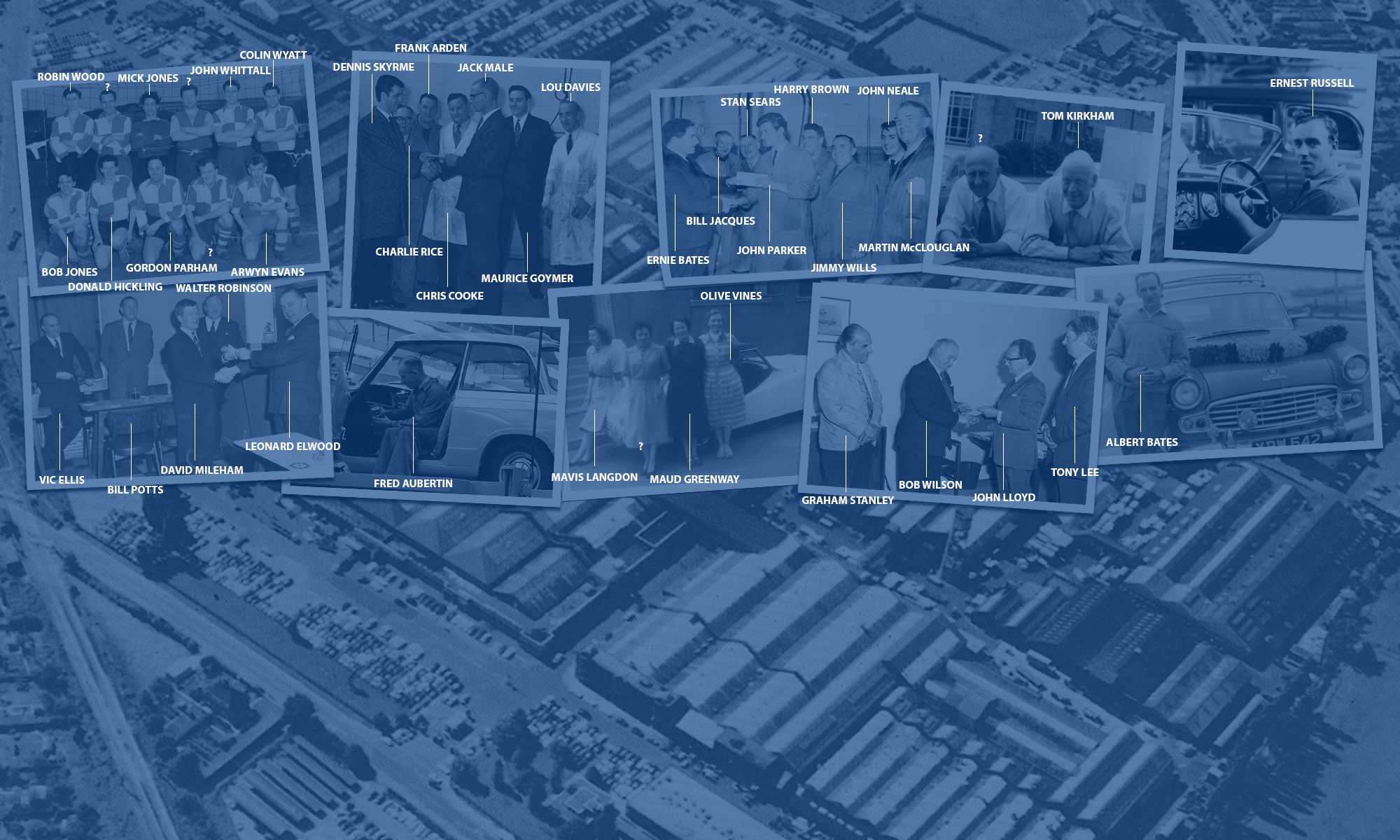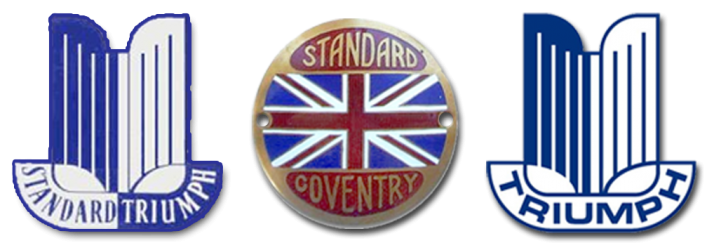For the Standard Triumph website – I know it reads like a CV but there’s no other way to reflect my experience and the great job that the Triumph Motor Company, in its many iterations, positively encouraged its people’s development.
Started work at the Standard Triumph 1971 straight from School aged 16
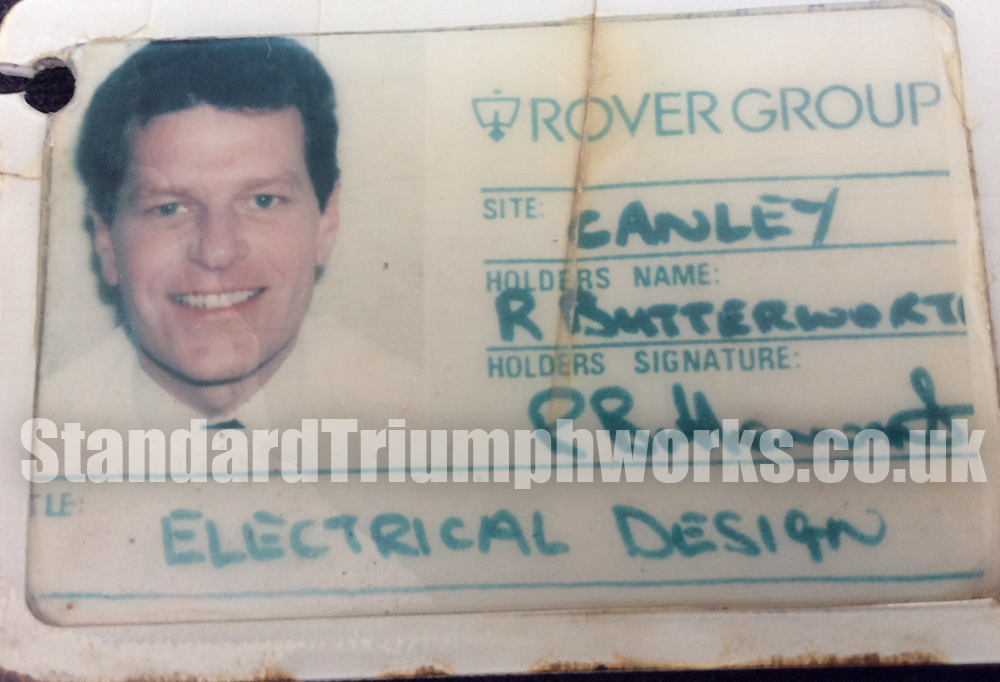
After a year in the Training School, on the shared site for the Herald & Spitfire Body Build and paint , in Torrington Ave, Tile Hill Coventry, which was a great introduction to adult working, training included; milling, turning, bench fitting (“metal fitting” – blue marking out, chiselling, sawing, filing, scraping, welding) detailed technical drawing and project reporting writing, people development awareness, team building & all the usual team sports. We were also very lucky to be able to visit many Engineering manufacturers, a memorable visit was to the grinding wheel development and manufacture of massive industrial grinding wheels. The lunch time was held in their Social Club, where the bar was on free vend…….imagine 40 odd 16 year olds allowed drink beer, wow.
My first Canley (the big factory) placement was in the Engine Build Shop – 300 engines a day, from engine block preparation, core plug fitting and oil gallery plugging, through to con rod weighing, balancing, assembly with pistons, cylinder head assembly, fitting and valve clearance adjustments; for all of the Triumph Products; Spitfire, TR6, Dolomite, Stag, moved onto engine rectification, loved it.
Moved onto the Rocket range – all vehicle assembly, as above, then moved in to the whole vehicle rectification (Dudline) roller test and final inspection, with Tony Bryan and Dave Lines, and many others, this was great too.
The next Placement was within Unipart, Building 40, in a small team of only 3 of us, building specialist orders for global supply such as short engines, completed engines, gearboxes, steering and suspension assemblies. For UK and World wide supply, with Alf Tearn. Thought it couldn’t get any better.
Spent a year in Press-cars on the A45 Allesley, now HPL, insane, detailing and perfectionist preparation of cars for Saudi Royalty, show cars etc, with Jim Ryan, the workshop Foreman and Dave Gleed and Colin (sorry forgotten the surname) still lives in Eastern Green.
And then “Promoted” to the Transport Garage 1973 working on everything from HGVs, Jags, JCBs, forklifts trucks (gas, petrol, diesel and electric) cranes, dumper trucks, lawnmowers, plant generator engines, fire engines and ambulances. Passed HGV class 1 driving test, aged just 21, covers everything including artics. Did many night shifts, mainly to help (my mates) the old guys, working till in their 70s in those days, who had a fear of them, not wanting to leave their families etc. Some names; Ralph Wood, Bob Vickers, Pete Thornycroft, Bob Teggin, Paul Dubock, Ian Jones, Charlie Wells, Ted Challis, George Alder, Ivor Lawton, Gordon Emery, Harold Jones, Terry Summerton and Dave Stansfield. Don Walters, Plus many more.
The Old Engineer; Dave Stansfield, joined the Transport Garage in about 1974,I’m still working with him (he’s 82 this year) now and again, in 2023 at his workshop at the farm near Berkswell.
***
In the late 80s what was left of the Garage team, we were relocated to Fletch South, the previous Quality Department (down the hill, behind the Tool Room, the basement to Building 40) got great support from Mike Hales (his input to the Triumph Website, encouraged me to write this, along with my son Michael asking – do you know anyone in this photo ………and Pete Chapman; until eventually being disbanded, in about 1992. During the latter years, took the opportunity to offer a couple of Suggestions in the Company wide initiative, having two notable rewards, bought a brand new Mini Mayfair, from the(MCP) management company car plan, having contact within while working with MCP on PDI ing many cars for the company managers, with one award and traded up to a Rover 214 with the second award, a year or two later. Having a Rover was still a big deal, in those days; late 1980s.
1987/8 was transferred to the Prototype Build Department, based in Building 40, with Brian King (manager)and Brian Griffin ( 1st class engineer) building, stripping and inspection of the Engineering development cars eg durability, corrosion, tested and completed prototypes, took the opportunity to apply for a role in Electrical Engineering Department;
1988 joined EE Electrical Engineering Department, (also based in the Building 40) with Iki Bilkhu Team Leader and Paul Kearns friend and Principal Engineer, responsible for design development, test & validation of all electrical components & systems, through to production, quality engineering, testing and reporting on failed in Service parts.
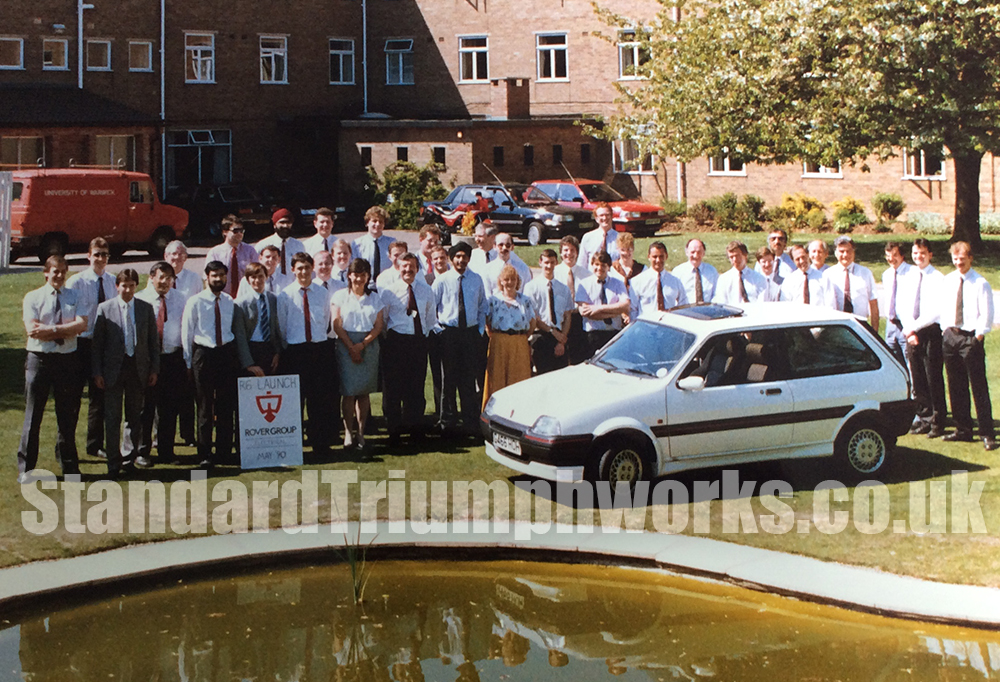
1990 Moved into the Electrical wiring harness design team, with Steve Eyre (Team Leader) focusing on the R6 project, code name for the Rover 100. As usual cost pressure on all projects for all COCs (Engineering – Centre of Competencies) to reduce costs, particularly component piece price, after only a few weeks, determined that if a body hole was punched 1/2mm Bigger, it would forgo the need of the expensive link lead, saving of £1 a car, considered to be a large saving (calculated on a hundred thousand cars a year) towards the struggling EE challenge. (No personal reward, due to being part of my role, but stood me in good stead for future roles and my personal development) Continued to settle in my new role and became the unofficial link to the Electrical Launch Team Leader, helping to resolve daily engineering issues based at the Production Site; Longbridge, we EE part of the the engineering design team still based at Canley, Building 40. Discussed my ambitions with Bob Mustard, who aided my development to Team Leader along with Steve Eyre. Thanks to both and, others Paul Kearns and Geoff Cowen.
1992 Promoted to ElectricalTeam Leader, working with the Design Studio (Gerry McGovern) still based at Canley in Building 40, leading the development of the Electrical Engineering design for PR3 code name for MGF, the first All new MG for 30 years. Money and resources being tight, I also at the same time as leading the team, took personal responsibility to develop the vehicle lighting (over 25 headlight concepts were costed and feas’d) components all eventually agreed to be new designs to meet the style of this All New MGF sports car, the justification took massive personal effort, convincing the PR3 Chief Engineer Brian Griffin, Finance Director, Design Director and my Electrical Engineering Design Director, (the first and I believe the only car NOT to have Headlamp Levelling, which was made a legal requirement in 1995, I pushed for this, and gambled to delete HLL, due to MGF being rear engined minimising the effect on the front suspension, testing took place with support from our Product Assurance Department at our Gaydon test facility a little risky, but saving much needed monies to make the project finances work and get Company Approvals) all new lighting components; normally pulling on 2 or 3 additional manpower, plus additional resources. But did have good support from the lighting Staff Engineer; Dave Franklin, and Aftab Ahmed supporting as part of his Portfolio responsibility, we had some great times in France, Belgium, Italy and Germany visiting the development suppliers, eating and staying in the best restaurants and hotels. Another first was the development of the front direction indicators, being a push fit, no clips, or fixings required in manufacture or production. This as usual challenged by everyone (pop out under front impact, or getting stolen…..except finance and manufacturing for obvious benefits for them.
The MGF EE Team; A very small and very under resourced team, All Canley based; hard working in support of this common goal, to develop the (EE) Electrical Engineering Design content for the first all new MG for 30 years. I was lucky to have Tony Richards to develop the wiring system, later becoming the Lead Engineer for Aircon system for all MG and SAIC Europe products. And Vijay Patel who carried on with the ICE system and instruments proposed by Russ Giles.
Another first was (in the world I think, but definitely in Europe, was the Electrical Power Steering, on MGF, again at risk, but the rear engine configuration, having lower front axle weight and steering loads, made this a consideration….a bit of a risk needing to be proved out during the program: Test and Development phase…..phew it worked, but not without challenges. The system was taken from a Japanese Fork Lift Truck, but the road inputs are very different for a sports car…..well done to EE Gerry Daykin & Chassis Engineering.
A 3 meter long speedo cable was developed, due to the unenviable cost challenge, it was decided to use a cable. This proved very costly from a resource point, me and the engineer Chris Vowles camping out at the poor old suppliers,, many many days and hours and hours, trying to resolve the “inherent” flutter seen on the speedo gauge. Eventually (in 1997, two years into production and inline with the product facelift) opting to change to electric speedo, but only when another program (facelift) could fund its development, that’s the way of life, in business.
Alarm ECU, this was quite new in 1995, the same engineer as above Chris, probably overstretched) developed the ECU, and like most electronic engineers had little concern about its installation on to the vehicle. Two weeks before preproduction, a water ingress (leak from the heater matrix) issue was raised…..me and our packaging engineer Pete Shaw worked day and night to find an alternative location, that met the installation requirements blah, blah, blah, anyway found one that satisfied ALL. Did no more than came in on Sunday and broke into the tinsmiths Shop at Canley (previous workplace for Pete, who then produced a tool jig, with poky yoke, accommodating and supporting the production of 100 “samples” keeping preproduction going, until getting the product change request PCR signed off with T&D, cost, supplier selection blah, blah blah, the usual everybody seemed to be working against us, but with determination getting there in the end due to max out effort. Lots of more challenges along the way, that only a good all rounder could achieve (mechanics my earlier role and experience being a normal role to resolve issues). Had some good days as well, for example in 1995 (the MGF launch year during the Easter celebrations At Gaydon Heritage center, my kids; Michelle & Michael never having so many Easter Eggs, hundreds, really……
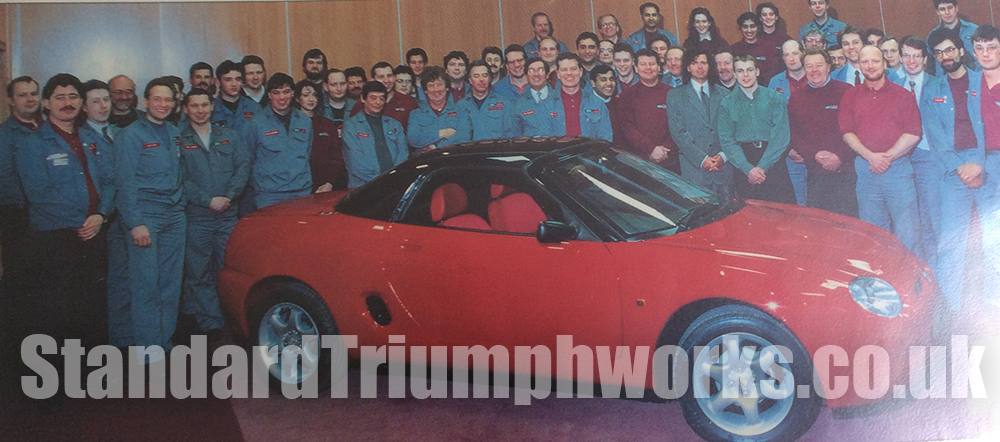
In 1995 the MGF was launched, after attending the Geneva launch, self funded with Project Chief Engineer Brian Griffin (the other one and his son Jim)This was a great experience driving from UK through the Alps to the show.
As part of the launch, a book of the MGF development was released, although small, had a little mention, by name, unique and a personal success for me.
1996 had my 25 Year Service with Battle of Britain Spitfire and hurricane and I think the Lancaster flightpass @ 25 year service celebration at Gaydon (now the Heritage Centre Museum). Fabulous evening, great recognition and a chance to meet the others from our year (only 4 still here from about 80 intake from 1971) Electrical Engineering Director Bruce Macaulay and his wife supported my wife Val and me, and were perfect company.
1996 MGF Team disbanded, But I was left in place at Longbrige, now responsible for the Mini Electrical content, with support from Gaydon, the now Engineering base for all COCs (Center of Competence), got recognition for delivering, in spite of the NEW Company wide organisation change……not working at its best, like most organisation changes; taking a couple of years to mature. From this recognition in 1997 was promoted to Senior Manager Electrical Engineering – Small & Medium Cars (responsibility for everything made at Longbridge) MGF, Mini, last British Mini, Rover 100, 200 & 400. Years later, I was told that it was suggested to get me to *head up the Solihull Electrical Engineering Team for Landrover products, I was unaware, but probably a good thing, this was a massive Team Structure and would have demanded regular large scale (over 200 team members) Team Briefings, never comfortable with the public speaking side of the job.
In 1998 or 99 went to Solihull (*unaware of above) and managed the Freelander NAS (North America Spec) project content for EE, working with Roush, on site at Solihll and out of their Leamington Development office backing, onto the Leamington park, by the cinema, pump rooms and the river leam.
Finally got promoted to Senior Manager. Unknown to us BMW were in the process of selling us off, MG & JLR, now they had ripped off the 4 wheel drive from LandRover and nicked the MINI from MGROVER. The toupe rules applied, and so was back with MG at Longbridge.
As usual money was tight but the MG products needing a refresh, my offer was to achieve maximum change for the lowest investment, this was to introduce new headlights, adding the Amber Direction Indicator, new rear lamps, changing the rear lens colour to clear, brightening them up. Not my area, but subliminal message left on the conference white board for “big red calipers, either worked, or just a coincidence red brake calipers were on the spec.
1999 supported the MGF Trophy development , as always limited resources and budget. This was a beefed up engine, with a sports body kit, updated brakes, a front bib spoiler and the rear spoiler to stabilise the rear end at the higher speed. As usual always Engineering issues on even the most simplest product changes….so it would seem, this time there was a lot of deliberation over the rear spoiler, causing a clash with the radio antenna, much discussion over new rear tonneau (wing) to allow a relocation of the Antenna location, no money in the budget, caused infeasibility of the program due to investment needs and body complexity concerns, all the way through the manufacturing process. (Not blowing my own trumpet) but yet another pragmatic solution, of rotating the footprint for antenna locator with an increased key-way slot accommodating both installations, rotate left for base car and right for Trophy. This got the go ahead.
2000 went to India with all other COC & Lead Engineers in support to the Board Director John Edwards to review the feasibility of the TATA (eventual owners of Jaguar Land rover) Indi car, that became the City Rover. Trying to apply the Rover design ques and features, for the EE content of, new front and rear lighting treatment, adding the Rover corporate front fog lights, roof aerial, column stalks and radio. Really enjoyed working in India, very capable Engineers.
2002
Involved in the development and buy out of Qavale Mangust, at the Modena Factory in Italy, Ferrari home ground. What a treat.
In 2002, ready for the 04 Model Year, all products were refreshed but with cost down challenges.
In 2003 was now seconded into The Purchasing Department, reporting directly to both the Purchasing and Engineering Directors, Larry Beard /Geoff Cowen and the Logistics Board Director Tony Shine; this was probably my most challenging role, responsible for ALL (everything) Engineering COCs in delivery of the Global Sourcing strategy, having engineers and their families and partners based around the world, from Longbridge, South Africa, India, full COC Team based and supported by frequent business trips to China. My success in this role stood me in good stead, being recruited into what was set up and called Ricardo 2010, working as the main engineering team supporting Chinese company SAIC, and much later returning back to Longbridge (2007) with the MG team, purchased by Nanjing staying in this role until 2015 and finishing. During this time;
2005 remotely managed the Asin Warner Auto gearbox into the Rover 75, fell in love with the car and bought a Rover75, and kept it for 7 or 8 years, Other jobs were the development of the MG3 Electrical Content, includes the iPod themed radio style. And all other features for this all new car. Next project was the MGZS, first SUV for MG and SAIC, must say all very good cars engineered & developed with the UK Team in conjunction with the fast developing Chinese Teams. Ambitious
Others bits of interesting info;
Moved into Marina Close with mum and dad aged 7, this is relevant, found out years later, the houses were built by a group of friends from the Triumph Car company, known locally has the Triumph Houses.
Getting the job at the Triumph- Even at the first interview, I went dressed very responsibly, in my older brothers green (itchy thing) jacket, looking like a young Geography teacher. On arrival this very thuggish looking skinhead, severe acne , not his fault, but paints the picture, 6’6” bovver boots, Trilby hat and Crombie stood alongside, obviously no conversation, or eye contact…..Kono, we became best friends, and he (Albenas Verladas Koncevicious) was even my best man…another wow…I reckon this saved my bacon, but didn’t work it out until much later in life.
Life long friends Ray Cummiskey, Martin Talbot and Les Campbell even though don’t see each other much these days
After rejecting a well paid job at Masseys of £16, per week, took the job offer at the Standard Triumph starting wage was £6, being more interested in cars, than tractors, but still quite like them
So, so proud to be called a mechanic in the Triumph Transport Garage, after all, my Grandad Ellis Jervis was the same, but at the Coventry City Council Transport Garage,
After joining the Transport Garage, got to know everyone, everywhere in the factory, had an internal (painted yellow) Austin Gipsy- the yellow peril. A pass to all areas. One day I bought some new jeans, fed up with home alterations, loosing the very important Wrangler stitching to the hem, a lovely lady in the seat Trim shop did them for me……How cool, making a difference……and this was in about 1975.
In 1975 Bought my Spitfire, Harry Johnson would scrounge a lift most days and if Val my girlfriend came to meet me (waiting by the gatehouse, no phones in those days) Harry would get in the back, through the Zip down rear window), not bad for a sixty year old.
Tyres
During my early time in the Transport Garage, I worked alongside Gordon Emery, known has Rugby. Repaired all tyres for all types of vehicles, as mentioned earlier. The most difficult to remove and repair, were the HGVs and the JCB rears, as well as some of the forklift trucks and plant gear, having very heavy duty wheels and tyre structures, needed to carry the very heavy truck and components pallet weights.
Suggestion Scheme
Had two major success, one when I bought the Mini Mayfair A333HDU, and one when I bought the Rover 213 ?666??? , owning a Rover was still a rare and quite special at the time
Bob Butterworth
